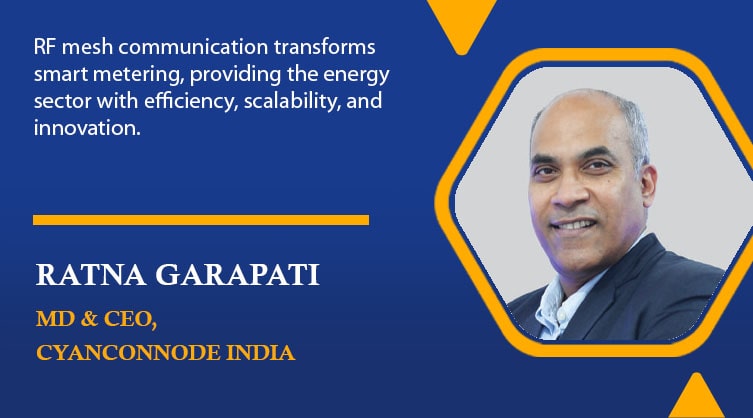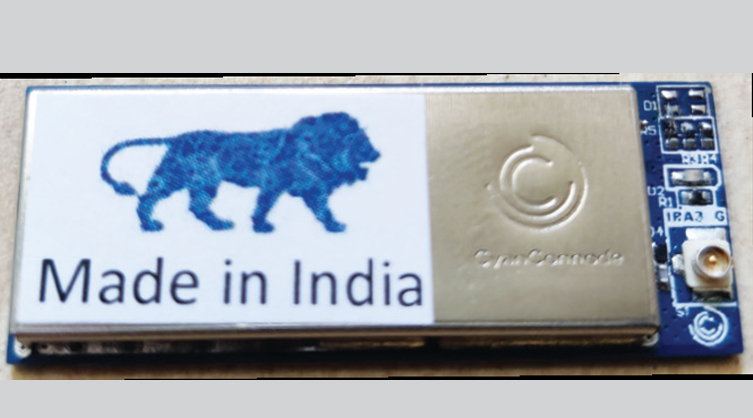Our adoption of Wi-SUN standards fosters integration across different technologies and manufacturers
By EPR Magazine Editorial August 25, 2023 11:47 am IST
By EPR Magazine Editorial August 25, 2023 11:47 am IST

Ratna Garapati, MD & CEO, CyanConnode India, in an interview with EPR Magazine delves into the transformative impact of smart meters, Head End Systems (HES), and cutting-edge communication technologies on the energy sector.
How are smart meters transforming the power sector?
Smart meters represent a paradigm shift in the power sector, creating a more responsive and efficient energy grid. Several technological advancements, like real-time energy monitoring, remote diagnostics and control, demand response management, and integration with renewable energy, greatly contribute to the power sector’s empowerment.
Smart meters are the building blocks of a smart grid, where everything from power generation to consumption is interconnected and optimised through intelligent automation and analytics. It lays the foundation for a more resilient, flexible, and efficient power infrastructure.
Real-time energy monitoring enables more informed decision-making, empowering consumers to reduce waste and utilities to optimise energy distribution. The ability to remotely monitor and control smart meters means that utilities can quickly identify and rectify issues. This improves service quality and reduces operational costs through preventive maintenance.
Furthermore, utilities can implement demand response strategies by understanding energy usage patterns. This helps balance the energy supply and demand, especially during peak periods, leading to increased grid stability and reduced cost.
When we talk about integration, smart meters facilitate the integration of renewable energy sources into the grid by providing more granular control and feedback. This helps utilities manage the variability of renewables, fostering a cleaner and more sustainable energy landscape.
How does integrating advanced communication technologies with smart meters drive greater grid reliability and promote energy conservation in the evolving energy landscape?
Integrating advanced communication technologies with smart meters is pivotal for enhancing grid reliability and promoting energy conservation, and enabling real-time data transmission grants utilities immediate insights into grid-wide energy consumption for consistent supply, even during peak periods. This synergy aids grid stability through demand-side management and load control in diverse regions. Dynamic pricing models motivate consumers to shift usage from peak to peak, while seamless communication with resources like solar panels adapts to renewable energy fluctuations. Robust security protocols bolster grid integrity against cyber threats.
This integration also empowers consumer engagement by providing insights into energy consumption patterns, enabling informed decisions, and aligning with energy literacy initiatives. In unique markets like India, this amalgamation isn’t just technological advancement but a strategic approach for a sustainable energy future. The symbiosis of smart meters and communication technology transforms energy management, distribution, and conservation.
CyanConnode, India’s prime private provider of smart IoT communication solutions for AMI infrastructure, embodies innovation commitment. We ensure robust security protocols, acknowledging data integrity’s significance in today’s interconnected energy landscape. Our solutions contribute to efficiency, sustainability, and industry security standards tailored to India’s distinct demands and opportunities.
What role does HES play in empowering consumers to optimise energy consumption and participate in the reduction of carbon footprints?
The Head End System (HES) is a crucial component of smart metering architecture, connecting a utility’s metering infrastructure with its back-office applications. Its core role involves automated meter data acquisition, ensuring precise scheduling and collection without human intervention. HES aggregates, securely stores, and provides access to metered data, efficiently managing connectivity.
An essential HES feature is its adherence to BIS/IEC standards, promoting interoperability among metering systems, seamless integration with the Meter Data Management System (MDMS), and utility enterprise software. This enhances customer relationship management, billing, and communication efficiency.Operationally, HES synchronises with the AMI’s central timestamp, registers gateways, DCUs, and smart meters, and enables bidirectional communication. It forwards messages between MDM and field devices, facilitating dynamic pricing for energy optimisation and carbon footprint reduction.
HES selection, while influenced by associated smart meters and gateways/DCUs, should remain independent for MDM interoperability. Open standards play a pivotal role in HES choice.
HES becomes a linchpin in the smart metering ecosystem by monitoring communications health. It enables utilities to offer tailored energy solutions, encouraging responsible consumption and contributing to a sustainable energy future.

What are the challenges and opportunities in implementing robust communication protocols for smart metering and HES amidst the growing demands of the energy ecosystem?
Implementing robust communication protocols for smart meters and head-end systems (HES) amidst the energy ecosystem’s growing demands presents challenges and opportunities. Ensuring interoperability across various components is complex but vital for seamless communication. In this context, CyanConnode’s adoption of Wi-SUN standards is exemplary, fostering easy integration across different technologies and manufacturers. Security is another significant concern; robust protocols must protect against cyber threats and unauthorised access. CyanConnode recognises this challenge and has invested in advanced security measures to ensure data integrity without compromising performance.
Scalability issues, regulatory compliance, and cost considerations also pose challenges. The design must be scalable to accommodate an increasing number of connected devices, comply with diverse data privacy and transmission regulations, and remain cost-effective. Despite these hurdles, there are numerous opportunities to explore. Robust communication protocols enhance grid reliability, empower consumers with real-time data access, and facilitate the integration of renewable resources. They also promote operational efficiency and foster industry innovation and collaboration.
The challenges are substantial, but the rewards are significant. By focusing on robust communication, innovation, and collaboration, the energy sector can create a more efficient, secure, and sustainable future, and companies like CyanConnode are at the forefront of this transformation.
Which innovative communication technology transforms smart metering and its impact on the energy sector?
Globally, RF mesh communication technology transforms smart metering, demonstrating unparalleled effectiveness and scalability. With over 425 million smart meters connected on RF mesh and an additional 150 million+ on a combination of PLC and RF, it’s becoming the standard for flexible and robust communication for futuristic energy infrastructure. In India, where the demand for efficiency and adaptability is paramount, RF technology lays the groundwork for next-generation solutions within the ambit of smart metering and smart grid, setting the stage for innovative players like CyanConnode and their cutting-edge Omnimesh solutions.
The energy sector in India is experiencing a transformation through innovative communication technologies, with CyanConnode’s Omnimesh solution playing a significant role. Our Omnimesh solution employs state-of-the-art silicon (currently FG12 and soon FG25) that meets the requirements for price and functionality, and its integration with the Wireless Smart Ubiquitous Network (Wi-SUN) ensures scalability and interoperability. CyanConnode has harnessed Wi-SUN’s advantages, such as communicating across different vendors’ devices without compatibility issues and emphasising robust IP-based security technologies. The result is a uniquely robust and adaptive solution catering to the growing demands of smart metering and utility management.
CyanConnode’s Omnimesh offers advanced security measures that keep communications private and tamper-proof, resisting potential attacks. With long-range sub-GHz wireless connectivity and scalability with customer demand, the Omnimesh solution sets a new standard in smart metering, enhancing the energy ecosystem’s efficiency, security, and sustainability. The integration of these advanced technologies positions CyanConnode at the forefront of smart metering transformation, contributing to a more responsive and responsible energy sector.
We use cookies to personalize your experience. By continuing to visit this website you agree to our Terms & Conditions, Privacy Policy and Cookie Policy.